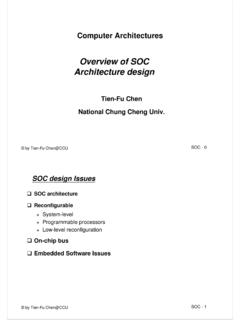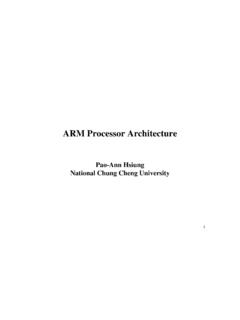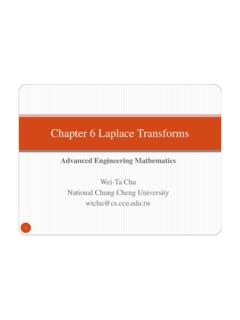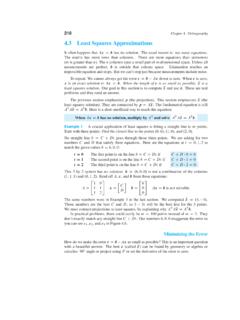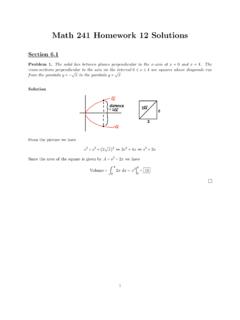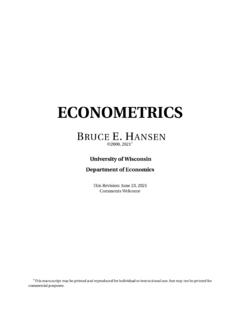Transcription of Chapter 9 Newton's Method - National Chung Cheng University
1 Chapter 9 Newton s MethodAn Introduction to OptimizationSpring, 2014 Wei-Ta Chu1 Introduction2 The steepest descent Method uses only first derivatives in selecting a suitable search direction. Newton s Method (sometimes called Newton-Raphson Method ) uses first and second derivatives and indeed performs better. Given a starting point, construct a quadratic approximation to the objective function that matches the first and second derivative values at that point. We then minimize the approximate (quadratic function) instead of the original objective function.
2 The minimizer of the approximate function is used as the starting point in the next step and repeat the procedure iteratively. Introduction3 We can obtain a quadratic approximation to the twice continuously differentiable function using the Taylor series expansion of about the current point , neglecting terms of order three and higher. Where, for simplicity, we use the notation Applying the FONC to yields If , then achieves a minimum at Example4 Use Newton s Method to minimize the Powell function: Use as the starting point.
3 Perform three iterations. Note that . We have Example5 Iteration 1. Example6 Iteration 2. Example7 Iteration 3. Introduction8 Observe that the th iteration of Newton s Method can be written in two steps as 1. Solve for 2. Set Step 1 requires the solution of an system of linear equations. Thus, an efficient Method for solving systems of linear equations is essential when using Newton s Method . As in the one-variable case, Newton s Method can be viewed as a technique for iteratively solving the equationwhere and.
4 In this case is the Jacobianmatrix of at ; that is, is the matrix whose entry is , Analysis of Newton s Method As in the one-variable case there is no guarantee that Newton s algorithm heads in the direction of decreasing values of the objective function if is not positive definite (recall Figure ) Even if , Newton s Method may not be a descent Method ; that is, it is possible that This may occur if our starting point is far away from the solution Despite these drawbacks, Newton s Method has superior convergence properties when the starting point is near the solution.
5 9 Newton s Method works well if everywhere. However, if for some , Newton s Method may fail to converge to the minimizer. Analysis of Newton s Method The convergence analysis of Newton s Method when is a quadratic function is straightforward. Newton s Method reaches the point such that in just one step starting from any initial point . Suppose that is invertible and Then, and Hence, given any initial point , by Newton s algorithm Therefore, for the quadratic case the order of convergence of Newton s algorithm is for any initial point 10 Analysis of Newton s Method Theorem : Suppose that and is a point such that and is invertible.
6 Then, for all sufficiently close to , Newton s Method is well defined for all and converge to with an order of convergence at least 2. Proof: The Taylor series expansion of about yieldsBecause by assumption and is invertible, there exist constants , and such that if , , we have and by Lemma , exists and satisfies 11 Analysis of Newton s Method The first inequality holds because the remainder term in the Taylor series expansion contains third derivatives of that are continuous and hence bounded on Suppose that.
7 Then, substitutingin the inequality above and using the assumption thatwe get 12 Analysis of Newton s Method Subtracting from both sides of Newton s algorithm and taking norms yields Applying the inequalities above involving the constants and Suppose that is such that Then13 Analysis of Newton s Method By induction, we obtainHence, and therefore the sequence converges to . The order of convergence is at least 2 because . That is, 14 Analysis of Newton s Method Theorem : Let be the sequence generated by Newton s Method for minimizing a given objective function.
8 If the Hessian and , then the search direction from to is a descent direction for in the sense that there exists an such that for all 15 Analysis of Newton s Method Proof: Let , then using the chain rule, we obtainHence, because and . Thus, there exists an so that for all , This implies that for all 16 Analysis of Newton s Method Theorem motivates the following modification of Newton s methodwhere that is, at each iteration, we perform a line search in the direction A drawback of Newton s Method is that evaluation of for large can be computationally expensive.
9 Furthermore, we have to solve the set of linear equations . In Chapters 10 and 11 we discuss this issue. The Hessian matrix may not be positive definite. In the next we describe a simple modification to overcome this problem. 17 Levenberg-Marquardt Modification If the Hessian matrix is not positive definite, then the search direction may not point in a descent direction. Levenberg-Marquardt modification: Consider a symmetric matrix , which may not be positive definite.
10 Let be the eigenvalues of with corresponding eigenvectors . The eigenvalues are real, but may not all be positive. Consider the matrix , where . Note that the eigenvalues of are . 18 Levenberg-Marquardt Modification Indeed, which shows that for all , is also an eigenvector of with eigenvalue. If is sufficiently large, then all the eigenvalues of are positive and is positive definite. Accordingly, if the parameter in the Levenberg-Marquardt modification of Newton s algorithm is sufficiently large, then the search direction always points in a descent direction.
